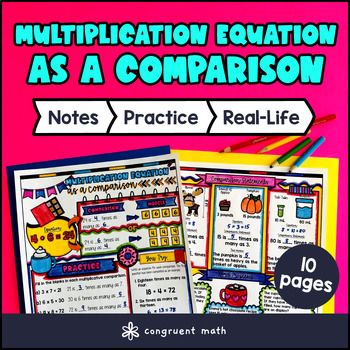Want more ideas and freebies?
Get my free resource library with digital & print activities—plus tips over email.
Join for Free Resources →
$4.25
Ever wondered how to teach multiplication as a comparison in an engaging way to your 4th grade students?
In this lesson plan, students will learn about multiplicative comparison and how to interpret multiplication equations as comparisons through artistic, interactive guided notes, checks for understanding, a color-by-code activity, and a maze worksheet. These activities help students build a solid grasp of solving multiplication word problems using comparison.
The lesson culminates with a real-life example that explores how multiplication comparisons apply to everyday situations, making math meaningful and practical.

$4.25
After this lesson, students will be able to:
Before this lesson, students should be familiar with:
As a hook, ask students if they have ever compared the number of items one person has to the number another person has—for example, “If Sarah has 3 times as many apples as Jake, how many apples does Sarah have?” Refer to the real-life examples on the last page of the guided notes as well as the FAQs below for additional ideas to spark student interest and connect to prior knowledge.
Use the first page of the guided notes to introduce the concept of multiplication as a comparison. Begin by explaining that multiplication can be used to show how one quantity is larger than another by a certain number of times. Walk through the key points: identifying when a multiplication equation represents a comparison, understanding the meaning of phrases like “times as many,” and translating comparison statements into multiplication equations. Use the checks for understanding on this page to verify that students can recognize multiplicative comparisons and write corresponding equations. Refer to the FAQ below for guidance on explaining common misconceptions, such as confusing additive and multiplicative comparisons.
Use the second page of the guided notes to deepen understanding by working through examples of solving multiplication equations as comparisons. Show students how to interpret each part of the equation in context and solve word problems that involve comparing quantities multiplicatively. Highlight strategies for determining which quantity is the “multiplied” one and which is the reference quantity, emphasizing vocabulary such as “times as many.” Use the embedded questions on the notes page to assess student comprehension and to clarify misunderstandings immediately. Refer to the FAQ below for suggestions on addressing typical student questions, including how to handle reversed order in comparison statements.
Based on student responses during these initial guided notes and checks for understanding, reteach specific concepts that students find challenging—for example, distinguishing between multiplication as repeated addition versus multiplication as comparison. If your class shows a wide range of proficiency, consider pulling aside students who need extra support for targeted reteaching, while allowing students who grasp the concepts quickly to begin exploring the practice exercises. This ensures all learners remain engaged and appropriately challenged from the start of the lesson.
Have students practice multiplication as a comparison using the color by code worksheet activity. Walk around to answer student questions.
Fast finishers can dive into the maze and problem sets activity for extra practice. You can assign it as homework for the remainder of the class.
Bring the class back together, and introduce the concept of how multiplication as a comparison is used in everyday situations, such as comparing quantities, prices, or measurements. For example, explain how a recipe might need 3 times as many cups of flour as sugar or how one store’s price is 4 times higher than another’s. This helps students see the value of understanding multiplication equations as comparisons in real-life problem solving. Refer to the FAQ for more ideas on how to teach it!
If you’re looking for digital practice for multiplication as comparison, try my Pixel Art activities in Google Sheets. Every answer is automatically checked, and correct answers unlock parts of a mystery picture. It’s incredibly fun, and a powerful tool for differentiation.
Here’s 1 activity to explore:
Multiplication as a comparison is a way of showing how one quantity is multiple times larger than another by using multiplication equations.
To write a multiplication equation as a comparison, identify the two quantities and express the larger quantity as the product of the smaller quantity and a number that shows how many times larger it is.
Multiplicative comparison word problems describe situations where one amount is a certain number of times larger than another. To solve them, you use multiplication to find the unknown quantity.
Teaching multiplication as a comparison can be done by: Using real-life examples to show one quantity is multiple times another. Guiding students to write and interpret multiplication equations for these problems. Using visual aids like doodles and color-coded notes for better engagement.
Multiplication as a comparison aligns with the Common Core State Standard 4.OA.A.1, which involves interpreting multiplication equations as comparisons between quantities.
Guided notes provide a structured way for students to learn by: Breaking down concepts step-by-step. Including checks for understanding to ensure students are following. Engaging students with doodles and coloring activities to reinforce learning.
Real-life applications include situations like: Comparing prices to find which item costs multiple times more. Figuring out how many groups of objects exist when one group is a multiple of another. Calculating total quantities in scaling recipes or projects.
Multiplication is used because: It efficiently shows how many times one quantity contains another. It simplifies repeated addition into a single operation. **It helps solve problems involving scaling or proportional relationships, which addition cannot represent easily.
You can check understanding by: Having students interpret multiplication equations in their own words. Asking them to solve word problems using multiplication to compare. **Using interactive activities like mazes or coloring worksheets that reinforce the concept.
Get my free resource library with digital & print activities—plus tips over email.
Join for Free Resources →